Service Citroen GRAND C4 PICASSO RHD 2017 2.G User Guide
[x] Cancel search | Manufacturer: CITROEN, Model Year: 2017, Model line: GRAND C4 PICASSO RHD, Model: Citroen GRAND C4 PICASSO RHD 2017 2.GPages: 523, PDF Size: 11.96 MB
Page 39 of 523
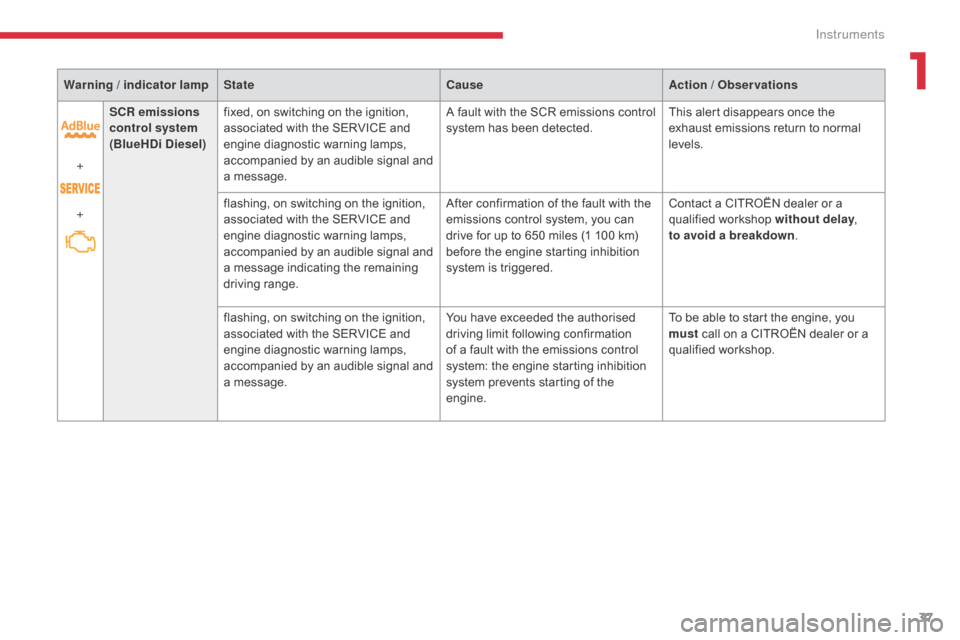
37
Warning / indicator lampState CauseAction / Observations
+
+ SCR emissions
control system
(BlueHDi Diesel) fixed, on switching on the ignition,
associated with the SERVICE and
engine diagnostic warning lamps,
accompanied by an audible signal and
a message. A fault with the SCR emissions control
system has been detected.
This alert disappears once the
exhaust emissions return to normal
levels.
flashing, on switching on the ignition,
associated with the SERVICE and
engine diagnostic warning lamps,
accompanied by an audible signal and
a message indicating the remaining
driving range. After confirmation of the fault with the
emissions control system, you can
drive for up to 650 miles (1 100 km)
before the engine starting inhibition
system is triggered.
Contact a CITROËN dealer or a
qualified workshop
without delay,
to avoid a breakdown .
flashing, on switching on the ignition,
associated with the SERVICE and
engine diagnostic warning lamps,
accompanied by an audible signal and
a message. You have exceeded the authorised
driving limit following confirmation
of a fault with the emissions control
system: the engine starting inhibition
system prevents starting of the
engine.To be able to start the engine, you
must
call on a CITROËN dealer or a
qualified workshop.
1
Instruments
Page 40 of 523

38
Service indicator
System which informs the driver when the
next service is due, in accordance with the
manufacturer's service schedule.
The point at which the service is due is
calculated from the last indicator zero reset,
according to the mileage covered and the time
elapsed since the last service.
For BlueHDi Diesel versions, depending on the
country of sale, the degree of deterioration of
the engine oil may also be taken into account.
More than 1 800 miles (3 000 km)
remain before the next service is due
When the ignition is switched on, no service
information appears in the screen.
Less than 600 miles (1 000 km)
remain before the next service is due
Example: 560 miles (900 km) remain before
the next service is due.
For 5 seconds after the ignition is switched on,
the screen indicates:
Between 600 miles (1 000 km)
and 1 800 miles (3 000 km) remain
before the next service is due
For 5 seconds after the ignition is switched on, the
spanner symbolising the service operations comes
on. The distance recorder display line indicates the
distance remaining before the next service is due.
Example: 1 700 miles (2 800 km) remain before
the next service is due.
For 5 seconds after the ignition is switched on, the
screen indicates:
5 seconds after the ignition is switched on,
the spanner goes off ; the distance recorder
resumes its normal operation. The screen then
indicates the total and trip distances. 5 seconds after the ignition is switched on,
the distance recorder resumes its normal
operation.
The spanner remains on to
indicate that a service must be carried out
soon.
Gauges and indicators
Instruments
Page 41 of 523
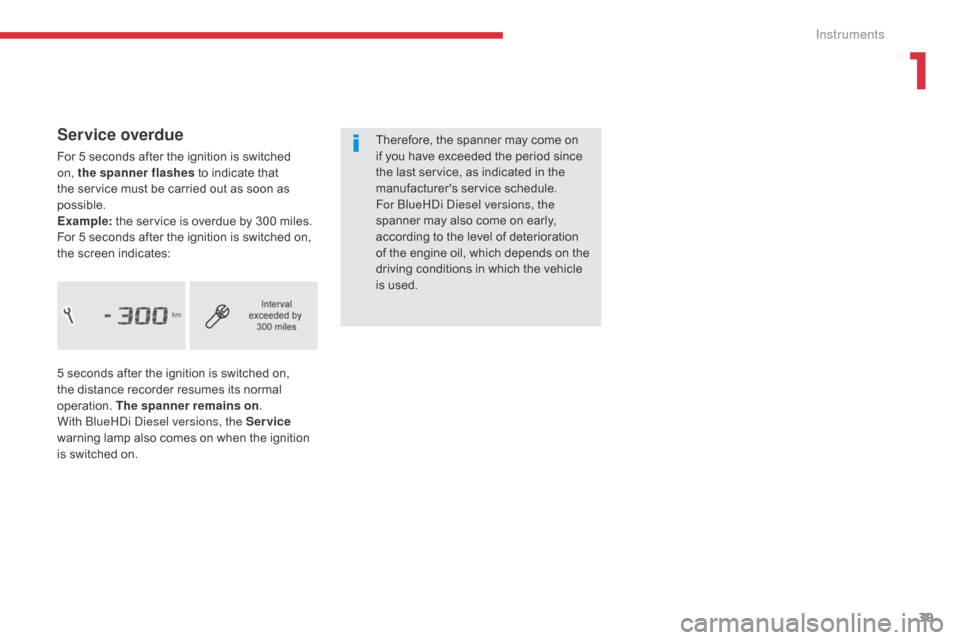
39
Service overdue
For 5 seconds after the ignition is switched
on, the spanner flashes to indicate that
the service must be carried out as soon as
possible.
Example: the service is overdue by 300 miles.
For 5 seconds after the ignition is switched on,
the screen indicates: Therefore, the spanner may come on
if you have exceeded the period since
the last service, as indicated in the
manufacturer's service schedule.
For BlueHDi Diesel versions, the
spanner may also come on early,
according to the level of deterioration
of the engine oil, which depends on the
driving conditions in which the vehicle
is used.
5 seconds after the ignition is switched on,
the distance recorder resumes its normal
operation. The spanner remains on .
With BlueHDi Diesel versions, the Service
warning lamp also comes on when the ignition
is switched on.
1
Instruments
Page 42 of 523
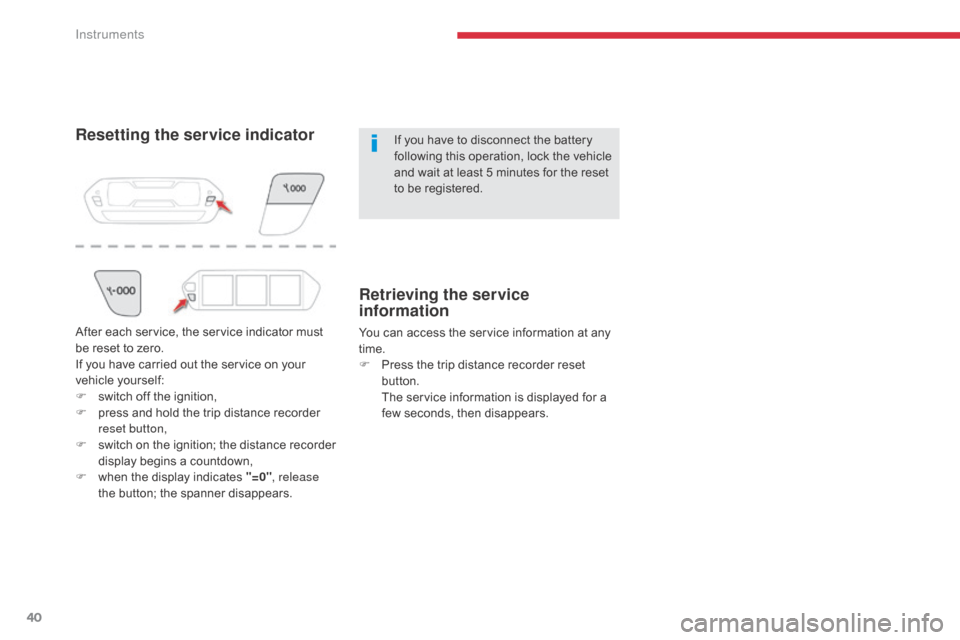
40
Resetting the service indicatorIf you have to disconnect the battery
following this operation, lock the vehicle
and wait at least 5 minutes for the reset
to be registered.
After each service, the service indicator must
be reset to zero.
If you have carried out the service on your
vehicle yourself:
F
s
witch off the ignition,
F
p
ress and hold the trip distance recorder
reset button,
F
s
witch on the ignition; the distance recorder
display begins a countdown,
F
w
hen the display indicates "=0" , release
the button; the spanner disappears.
Retrieving the service
information
You can access the service information at any
time.
F
P
ress the trip distance recorder reset
button.
T
he service information is displayed for a
few seconds, then disappears.
Instruments
Page 44 of 523
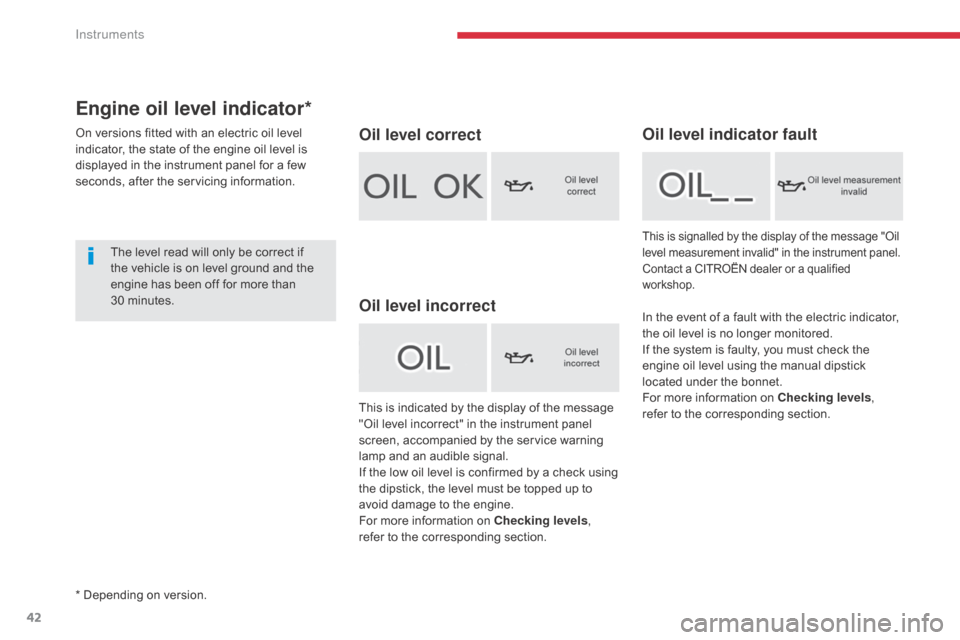
42
Engine oil level indicator*
On versions fitted with an electric oil level
indicator, the state of the engine oil level is
displayed in the instrument panel for a few
seconds, after the servicing information.The level read will only be correct if
the vehicle is on level ground and the
engine has been off for more than
30
m
inutes.Oil level correct
This is indicated by the display of the message
"Oil level incorrect" in the instrument panel
screen, accompanied by the service warning
lamp and an audible signal.
If the low oil level is confirmed by a check using
the dipstick, the level must be topped up to
avoid damage to the engine.
For more information on Checking levels,
refer to the corresponding section.
This is signalled by the display of the message "Oil
level measurement invalid" in the instrument panel.
Contact a CITROËN dealer or a qualified
workshop.
In the event of a fault with the electric indicator,
the oil level is no longer monitored.
If the system is faulty, you must check the
engine oil level using the manual dipstick
located under the bonnet.
For more information on Checking levels,
refer to the corresponding section.
* Depending on version.
Oil level incorrect Oil level indicator fault
Instruments
Page 46 of 523

44
Remaining range between 0 and 350 miles (0 and 600 km)
When switching on the ignition, the SERVICE
warning lamp comes on and the AdBlue
warning lamp flashes, accompanied by an
audible signal and the display of a message
(e.g. "Top-up AdBlue: Starting impossible in
350 miles") indicating the remaining range
expressed in miles or kilometres.
When driving, the message is displayed every
30 seconds until the fluid level has been
topped-up.
Go to a CITROËN dealer or a qualified
workshop to have the AdBlue
® fluid topped-up.
You can also top-up the fluid yourself.
Other wise you will not be able to restart your
engine. Breakdown related to a lack of AdBlue
®
When switching on the ignition, the SERVICE
warning lamp comes on and the AdBlue
warning lamp flashes, accompanied by an
audible signal and the display of a message
(e.g. "Top-up AdBlue: Starting impossible").
The AdBlue
® tank is empty: the system required
by regulations prevents engine starting.
To be able to start the engine,
we recommend that you call on
a CITROËN dealer or a qualified
workshop for the top-up required.
If you carry out the top-up yourself, it
is essential to add at least 3.8 litres of
AdBlue
® to the tank.
For more information on AdBlue® and the SCR
system, and in particular on topping-up, refer
to the corresponding section.
Instruments
Page 47 of 523

45
In the event of a fault with the SCR emissions control system
In the event of the detection of a fault
The AdBlue, SERVICE and diagnostic
warning lamps come on, accompanied by an
audible signal and the display of the message
"Emissions fault".
The alert is triggered when driving when the
fault is detected for the first time, then when
switching on the ignition for subsequent
journeys, while the fault persists.During an authorised driving phase (between
650 miles and 0 miles) (1 100 km and 0 km)
If a fault with the SCR system is confirmed
(after 30 miles (50 km) covered with the
permanent display of the message signalling
a fault), the SERVICE and engine diagnostic
warning lamps come on and the AdBlue
warning lamp flashes, accompanied by an
audible signal and the display of a message
(e.g. "Emissions fault: Starting prevented in
150 miles") indicating the remaining range
expressed in miles or kilometres.
While driving, the message is displayed every
30 seconds while the fault with the SCR system
persists.
The alert is repeated when switching on the ignition.You should go to a CITROËN dealer or a
qualified workshop as soon as possible.
Other wise, you will not be able to restart your
engine.
A system that prevents engine starting is activated automatically from 650 miles (1 100 km) after confirmation of a fault with the SCR emissions
control system. Have the system checked by a CITROËN dealer or a qualified workshop as soon as possible.
If it is a temporary fault, the alert
disappears during the next journey,
after self-diagnosis of the SCR system.
Starting prevented
Every time the ignition is switched on, the
SERVICE and engine diagnostic warning
lamps come on and the AdBlue warning lamp
flashes, accompanied by an audible signal and
the display of the message "Emissions fault:
Starting prevented".
You have exceeded the authorised
driving limit: the starting prevention
system inhibits engine starting.
To be able to start the engine, you must
call on a CITROËN dealer or a qualified
workshop.
1
Instruments
Page 62 of 523
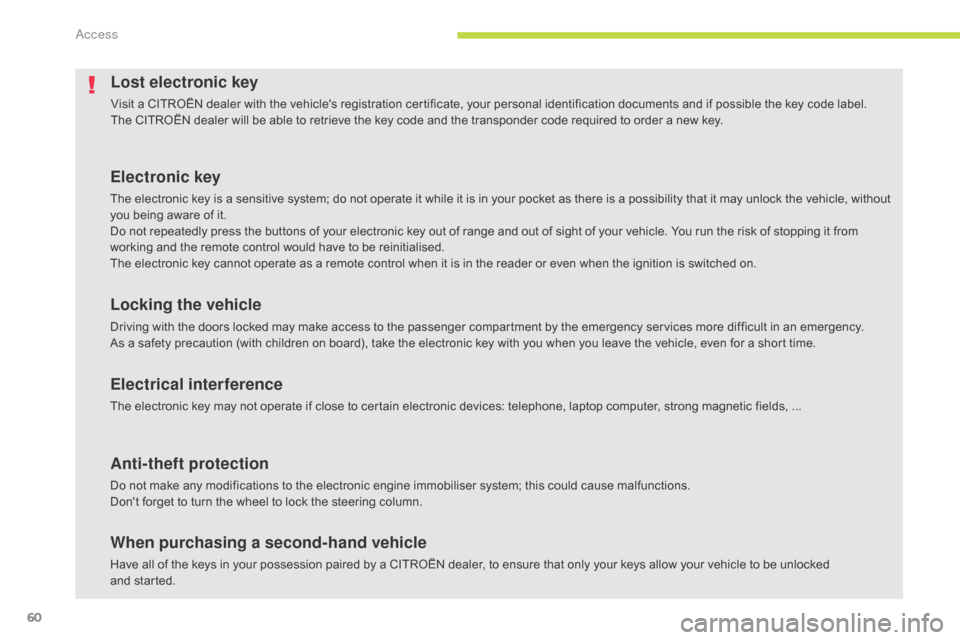
60
Lost electronic key
Visit a CITROËN dealer with the vehicle's registration certificate, your personal identification documents and if possible the key code label.
The CITROËN dealer will be able to retrieve the key code and the transponder code required to order a new key.
Electronic key
The electronic key is a sensitive system; do not operate it while it is in your pocket as there is a possibility that it may unlock the vehicle, without
you being aware of it.
Do not repeatedly press the buttons of your electronic key out of range and out of sight of your vehicle. You run the risk of stopping it from
working and the remote control would have to be reinitialised.
The electronic key cannot operate as a remote control when it is in the reader or even when the ignition is switched on.
Locking the vehicle
Driving with the doors locked may make access to the passenger compartment by the emergency services more difficult in an emergency.
As a safety precaution (with children on board), take the electronic key with you when you leave the vehicle, even for a short time.
Electrical interference
The electronic key may not operate if close to certain electronic devices: telephone, laptop computer, strong magnetic fields, ...
Anti-theft protection
Do not make any modifications to the electronic engine immobiliser system; this could cause malfunctions.
Don't forget to turn the wheel to lock the steering column.
When purchasing a second-hand vehicle
Have all of the keys in your possession paired by a CITROËN dealer, to ensure that only your keys allow your vehicle to be unlocked
and started.
Access
Page 63 of 523

61
Manual central locking
Central locking
F Press this button to operate the central locking of the vehicle (doors and boot) from
inside the vehicle.
F
P
ressing the button again unlocks the
vehicle completely.
Automatic central locking
of doors (anti-intrusion
security)
The doors and boot lock automatically when
driving, as soon as the speed exceeds 6 mph
(10 km/h).
To activate or deactivate this function (activated
by default):
F
w
ith the ignition on, press this button until a
message appears in the instrument panel.
When locking / deadlocking from the
outside
If the vehicle is locked or deadlocked
from the outside, the button is not
active.
F
A
fter normal locking, pull one of
the interior door handles to unlock
the
vehicle.
F
A
fter deadlocking, you have to use
the remote control, the Keyless Entry
and Starting system or the integral
key to unlock the vehicle. If one of the doors or the boot is
open, automatic central locking does
not complete: the sound of the locks
rebounding can be heard.
Transporting long or voluminous
objects
If you want to drive with the boot open
but the vehicle's side doors locked,
press the central locking control button
to lock the doors.
Driving with the doors locked may make
access to the passenger compartment
by the emergency services more
difficult in an emergency.
2
Access
Page 136 of 523

134
Emergency braking
In the event of a failure of the main service
brake or in an exceptional situation (e.g. driver
taken ill, under instruction, etc.) a continuous
pull on the control lever will brake the vehicle.
Braking takes place while the control lever is
being pulled. It is interrupted if the control lever
is released.
The ABS and DSC systems provide stability of
the vehicle during emergency braking.
If the emergency braking malfunctions, the
message "Parking brake control faulty" will be
displayed.
If a failure of the ABS and DSC systems occurs,
signalled by the illumination of one or both
warning lamps in the instrument panel, then
stability of the vehicle is no longer guaranteed.
In this event, stability must be assured by the
driver by repeating alternate "pull-release"
actions on the control lever until the vehicle is
immobilised.The emergency braking should only be
used in an exceptional situation.
Repeat this procedure to reactivate automatic
operation.
Reactivation of automatic operation is
confirmed by the indicator lamp in the
instrument panel going off.
Deactivating automatic operation
In some situations, such as very cold weather
or towing (caravan, recovery), it may be
necessary to deactivate automatic operation of
the system.
F
S
tart the engine.
F
A
pply the parking brake with the control
lever, if it is released.
F
T
ake your foot off the brake pedal.
F
P
ush and hold the control lever in the
release direction for at least 10 seconds
and no more than 15 seconds.
F
R
elease the control lever.
F
P
ress and hold the brake pedal.
F
P
ull the control lever in the apply direction
for 2 seconds.
Deactivation of the automatic functions
is confirmed by illumination of this
indicator lamp in the instrument panel.
F
R
elease the control lever and the brake
pedal. From this point the parking brake can only
be applied and released manually using the
control lever.
Driving